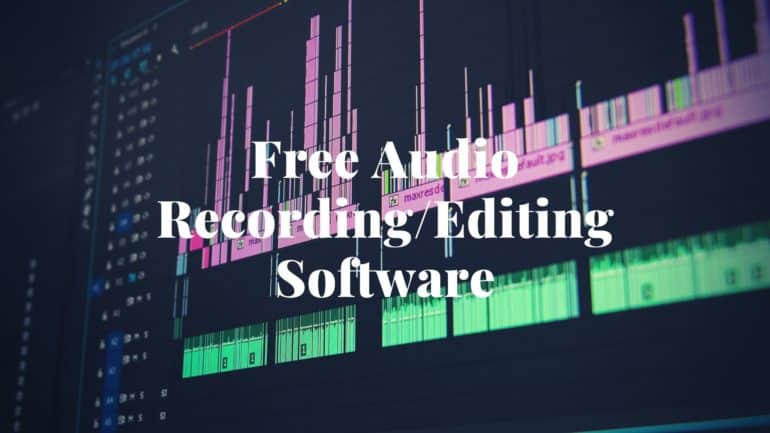Warning: Attempt to read property "post_content" on null in /var/www/thehomerecordings.com/wp-content/plugins/ultimate-addons-for-gutenberg/blocks-config/table-of-content/class-uagb-table-of-content.php on line 409
Warning: Attempt to read property "post_content" on null in /var/www/thehomerecordings.com/wp-content/plugins/ultimate-addons-for-gutenberg/blocks-config/table-of-content/class-uagb-table-of-content.php on line 409
Last updated on February 13th, 2023 at 02:37 am
If there’s one thing that really gets me going is when someone says that you need to have Pro Tools, Cubase… you name it, installed in order to be a good producer.
The funny thing is that this couldn’t be farther from the truth.
In order to be a good producer, you need to learn how to properly produce music, the software you use for recording/editing is secondary.
If you don’t have the proper knowledge, acoustic treatment, equipment, and skills, it doesn’t matter if you use the “best” software out there…
Your mixes will most certainly suck!
So, before I get into the free Audio recording software, there are some things that need to be addressed.
But first, something that is a lot more important than the editing software you use, which is…
Improve your skills
Just like with anything else in life, recording, mixing, and mastering are skills that need to be learned… and this takes time.
Think more about which of those skills you are lacking and focus on improving them instead of thinking that you need to purchase Pro Tools simply because someone said so.
If you are excellent at using any kind of software, let’s say Audacity, do you think that you could achieve the same quality mix on Pro Tools or Cubase?…
Probably not, right?… At least not until you get used to those DAWs.
While it might be a good idea to upgrade to some of the more professional recording software/DAWs at some point, I really don’t think that this should be a priority.
Lucky for you not only are there dozens of free recording programs out there…
But even Pro Tools, Presonus, and other of the big names, have free stripped-down versions of their most popular DAWs.
If you think that you might need a couple courses to improve your skills quickly, then let me recommend the loopmasters website where you can find loads of courses about almost anything music related.
Best Free Audio Recording Programs
Now that that’s out of the way it’s time to get into the list of the recording programs…
Note: You might be thinking “Hey, but my computer came with one pre-installed, can’t I use that one?”.
Well, yes and no…
If you own a Mac then it means that you get Garageband for free, and Garageband is definitely on this list since it’s excellent!
If that’s your case then yes.
If you own a PC, like most of us, then you will absolutely need to download another program.
Lucky for you, here’s a list of 10 great ones which not only are free, but also work great!
Note: I’ll end the post with the ones I like the most.
Let’s get started…
10. Traverso
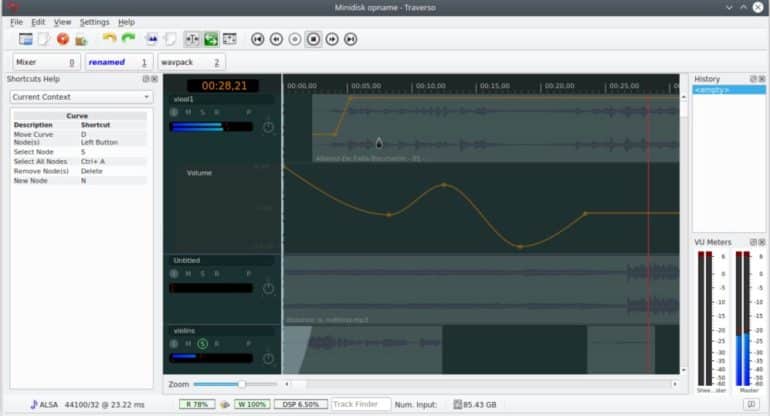
The whole idea behind Traverso is to make the workflow as easy as possible.
They achieve this by allowing you to control the entire program through mouse+keyboard shortcuts, which I know may sound a little intimidating at first…
But once you get the hang of it, you’ll be able to work that much faster.
Some cool features of Traverso are;
Non-destructive audio editing: This allows you to undo/redo as much as you want.
Cut the track into a million pieces, add effects, and more… and the original file will still be intact.
This is a great feature for beginners to have, since you can’t really run into any serious problems.
Burn directly to a CD: Yes, we almost don’t use CDs anymore, but it’s a nice feature to have.
Once you’re done with a project you can burn it directly on-to a CD without even leaving Traverso.
Note: This is not a simple recording program…
It’s actually a full DAW which is quite powerful and that certainly is capable of producing professional sounding music.
So, if you like using shortcuts and don’t mind that initial learning curve, by all means, give Traverso a try.
You can download it here.
9. Ardour

Ardour is yet another free DAW/audio recording and editing software that is both aimed at the seasoned producer as well as beginners.
It’s a fully featured DAW, and the whole point behind Ardour is to be the go-to choice for engineers who are on a budget and can’t afford to purchase a premium one.
Just like Traverso, Ardour features non-destructive editing as well as 32-bit float.
Not only that, but contrary to Pro Tools first, Ardour doesn’t put a limit on the number of simultaneous tracks you can use.
It also supports VST, LADSPA, AU, and LV2 formats so that you can use your favorite plugins.
Additionally, Ardour runs on JACK which is excellent at handling MIDI without any latency whatsoever.
Lastly, would I recommend Ardour to a complete newbie?
Probably not… and here’s why;
The user interface is a bit more complex than the one on other free recording software out there, like Garageband which is extremely easy to use.
However, I’ve you’ve ever worked with a real DAW before, Ardour will probably be easy to learn, plus it can do anything a premium DAW can.
You can download it here.
8. Jokosher

Jokosher is one of the most lightweight recording programs you’ll ever find.
It’s not really designed to be able to do any advanced mixing and mastering, like most other programs on this list…
However, what it lacks in functionality it more than makes up in ease of use.
Not only that, but it was designed to use concepts that musicians are more familiar with than the language used in most audio editing software…
Making it a good starting point!
Even though Ardour may not be as in-depth as some of the other DAWs on this list, it still features all the basic editing tools like splitting, trimming, etc.
It even comes with a decent number of instruments which can be added to a project.
However, if you want do add extra plugins like Orchestral VST, for example, you will only be able to add LADSPA plugins… which I know isn’t ideal.
All in all, Jokosher is a great free tool mainly due to its ease of use… it’s very similar to Garageband in that regard.
If you need to do some simple audio recording, mixing, etc., or if you want a simple tool for podcasting, then Jokosher might be the right fit.
You can download it here.
7. Ohm Studio
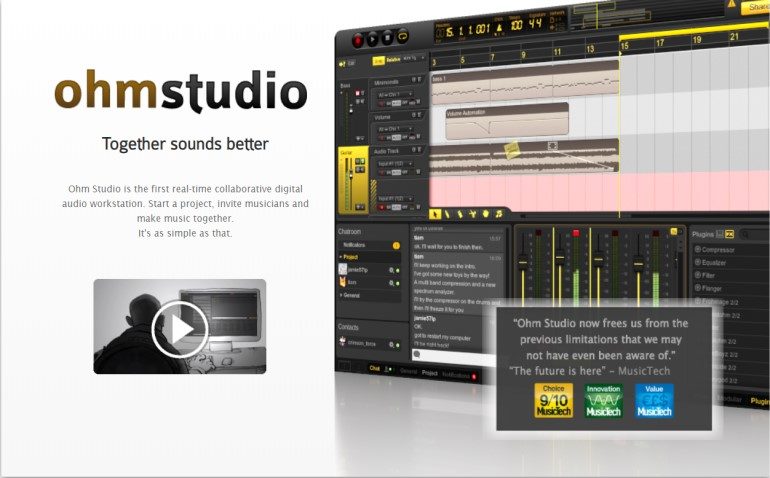
Ohm Studio looks like a regular DAW, or like any other audio recording software.
But what sets it apart from every other program on this list is not the number of plugins it comes with, or how powerful it can be…
What really sets it apart is that it’s a collaborative recording software.
What this means is that you can give access to other people and they can simultaneously work with you in real time on the same project.
The reason I included Ohm Studio in this list is exactly because of that one feature.
Other than that, it doesn’t offer anything that other recording software don’t.
It comes with a lot of effects and instruments that can be used completely for free, and it also supports VST plugins… but only 32-bit for now.
You can download it here.
6. Pro Tools First

Pro Tools First is the stripped-down version of the most popular DAW in existence…
It includes the Xpand!2 virtual instruments and UVI Workstation 3 sample player which give you access to a variety of sounds, from beats and loops, to power chords and more.
Since it’s a lite version of Pro Tools, it only allows for up to four simultaneous tracks to be recorded at the same time…
And 16 tracks can be played back at the same time.
I know this doesn’t sound like a lot but remember that it’s the free version and you can always upgrade later on.
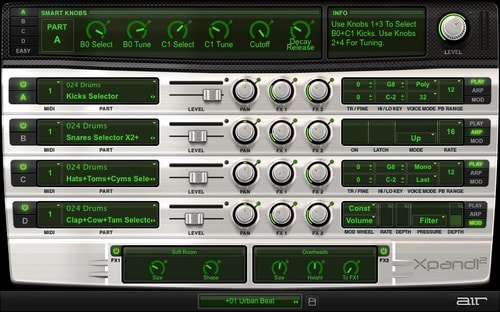
Pro tools First also comes with 23 effects and utility plugins, which are great for basic mixing procedures.
It is free to download and use, but you need to register with them and with iLoki also, which takes a bit of time.
Whenever you want to try out free software, having to jump through a couple of hoops isn’t the worst thing, but it would be much better if they didn’t make you do any of this.
Note: If you’re thinking about building a home studio, don’t miss out on this list I wrote about all the Home Studio Essentials you need!
You can Download it here.
5. Tracktion T7

Tracktion T7, just like Cakewalk, which I will talk about in a second, is a completely free and fully featured/unlimited DAW.
This means that there is no “Lite” version, there are no track limitations, no plugin limitations, or any other constraint of sorts like on Pro Tools First or Cubase LE.
The T7 version, and all the prior ones, are free.
This is because they want you to try them out and see if you like the workflow…
If you do, you can upgrade to the latest version that is now called Waveform 9, which isn’t free.
In order to get this one, you will need to register as well.
After this, simply select your OS and download.
The BIG difference between Tracktion T7 and all the other DAWs I’ve tried is that the workflow is very different.
You have your tracks, which go from left to right, like in any other DAW, but the Mixer isn’t on the bottom, like in EVERY OTHER DAW… it’s on the right.
The controls for every track are on that same track but on the right side of the DAW.
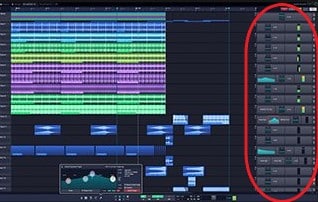
This might be a bit confusing at first, but it makes sense once you’ve gotten used to it.
However, even though getting used to the different workflow of Tracktion 7 can take some time…
Why would you spend a fortune in order to get some other DAW when this one, and Cakewalk as well, can do the same things but for free?
Definitely give it a try!
You can download it here.
4. Studio One Prime
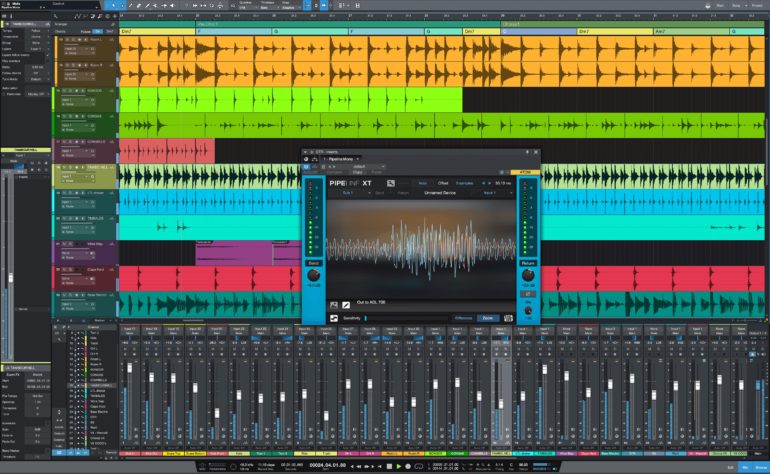
Studio One Prime is a beginner friendly DAW.
The user interface is extremely intuitive and easy to use and it offers a hassle-free workflow.
Therefore, it’s great for beginners since recording a demo in your bedroom without any prior experience won’t be such a headache.
I recommend Studio One Prime to people with no prior experience who just want to learn the basics of mixing music.
The biggest drawback it has is that it can’t load VST or AU plugins.
If you want to be able to do this, you will need to upgrade to Studio One Artist.
Note: In order to use VST/AU plugins in Studio One Artist, you will need to purchase a separately paid add-on for these VST/AU plugins to work.
Yes, this sucks… But the software itself is great!
Studio One Prime comes with nine Native effect Plugins like delay, distortion, etc. which are surprisingly good.
At the time of writing this article, the current version is Studio One 4 Prime.
The latest version introduces a couple of improvements added from the Artist and Pro editions of the Software.
These are; An improved instrument editing workflow, the introduction of drum and melodic patterns as well as MP3 encoding.
This is a stripped-down version of the Artist and Pro editions, if you need VST/AU plugins, or if you want more effects, you will have to either get another DAW from this list, of purchase the Artist or Pro editions.
Remember that the Artist version requires a separately paid add-on for VST/AU plugins to work.
Just like with most of the DAWs on this list, you will need to register in order to download it.
Still, I think that Studio One Prime is definitely worth checking out.
You can download it here.
3. Cakewalk by Bandlab
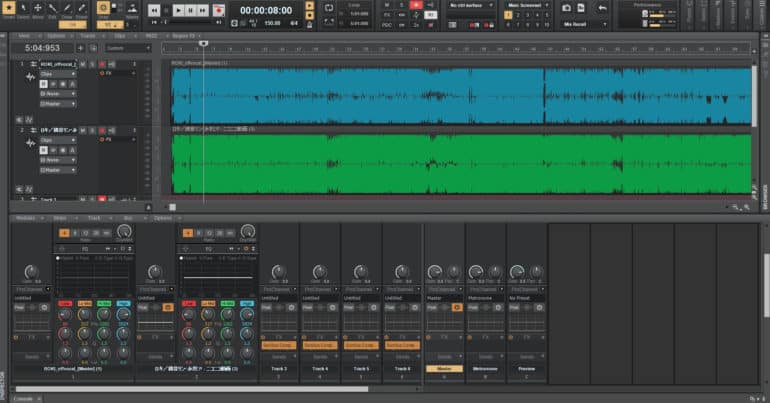
Cakewalk is considered to be the best free DAW out there, the one issue is that it’s only for Windows users (Windows 7 or higher and only 64-bit), but you are getting a $600 value DAW for absolutely free.
It’s basically a rebranded version of SONAR Platinum with all its professional features included.
One of the differences between Cakewalk and ProTools First or Cubase LE (light version of Cubase), is that those come with a couple restrictions;
Like limited simultaneous tracks recording and playing back, and some other features.
Cakewalk is just as powerful as the full versions of ProTools and Cubase, but 100% free!
Not only is Cakewalk my top choice for any free recording software out there, but it’s also the one I generally use the most.
For years now I’ve been using Cubase and I have to say that I really like the workflow…
But Cakewalk is very similar in the sense that it’s a full DAW, while still being absolutely free.
Of course, it comes down to your own preferences.
Maybe you like the interface of some other DAW better, but this one offers everything the full version of a paid DAW does, and more!
If you are a Windows user, then get Cakewalk, no questions asked!
Note: Once you downloaded Cakewalk, you will need to register (you can do this through Facebook or Google, it only takes one second).
Then you need to go to the “App” section and install Cakewalk.
You can download it here.
2. Audacity
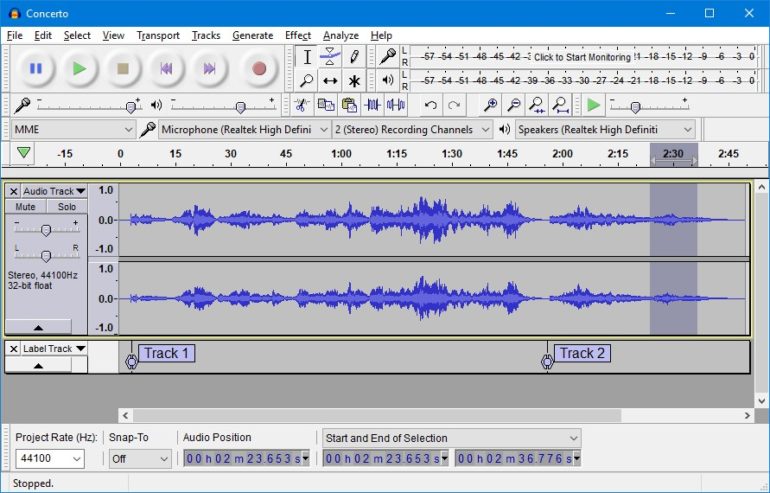
Audacity, while not being the most powerful program out there, is the go-to recording software for most beginner home music recording enthusiasts as well as podcasters.
The reason for this is that it’s fairly simple to use, which is ideal if you are a beginner.
The interface is simple and clean (Ideal for a newbie), which just means that the user experience as a whole will be much less complicated.
Not only that but it can record using your PC’s onboard sound card directly through the mic input and line-in input.
Live streaming is also an option if your sound card supports it.
It comes with quite the number of included effects which are useful for getting the sound you desire, from setting the levels right to changing the sound of your voice even.
From EQs, to pitch correction, delay, reverb, compressor, noise removal, and more… Audacity has got your basic effect needs covered.
Additionally, it even supports VST, LADSPA, AU, and Nyquist plugins, meaning that if you want to load a Drum VST plugin, you can.
Audacity supports a sample rate of up to 192kHz, which is far more than you’ll ever need since most of the times, even in professional studios, the sample rate is 48kHz.
But having the alternative to go this high will allow you to do some high-caliber recordings.
Note: You’ll need the appropriate gear to take advantage of this feature.
Audacity may not necessarily come packed with loads of features, but what it lacks in added functionality it more than makes up in simplicity.
This is why I think that it’s excellent for beginners, since it’s fairly simple to use while still providing you with a whole lot of options.
If you’re just starting to learn about audio engineering or if you are recording simple things, like a podcast, then Audacity is definitely worth considering.
You can download it here.
1. Garageband
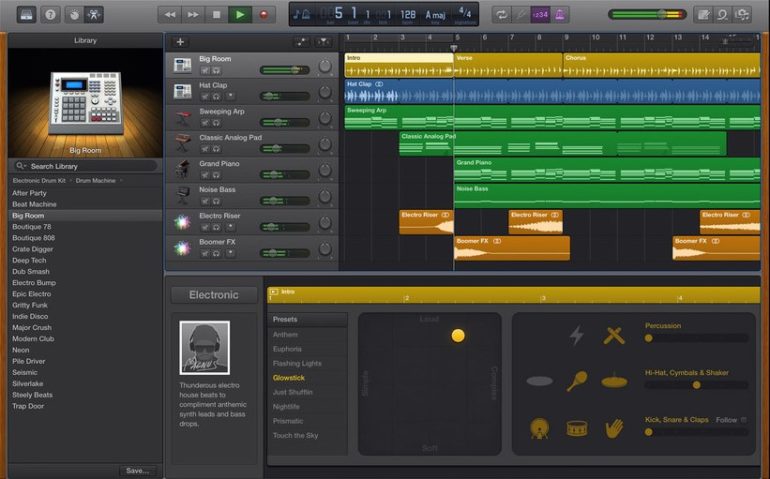
Garageband is an amazing DAW that comes free with any iOS device, if you own a Mac or an iPhone you will have access to it.
It is, essentially, a stripped-down version of Logic Pro X but completely free.
Garageband is a great place to start if you want to learn about multitrack recording, using MIDI and essentially mixing, before spending a lot of money on expensive software.
With Garageband not only can you produce a song on your computer but you also can produce an entire song using just your cellphone, since you have all the tools you need right there.
This means that if you own an iPhone and you want to record only using that device, Garageband will be the ideal choice for you.
I wrote an entire article on How to produce a song with no Studio Equipment which should be of use to anyone who wants to record using a mobile device.
Garageband is extremely easy to use, which is why I think it deserves the first stop on this list.
The interface is clean, the design is super intuitive… Perfect for any beginner!
Which one should you choose?
Well, this is a complicated question to answer…
The fact is that most of the audio recording/editing programs on this list will be able to do almost the exact same things properly.
However, this all depends on your overall music production knowledge.
If you are a complete newbie then I’d recommend Garageband, for Mac users, and Jokosher, for Windows users.
Garageband is pretty versatile and will allow you to create some pretty good sounding music.
Jokosher on the other hand, is very easy to use… but also very limited, and should be used as a jumping off point.
If you already know a bit about how to use a DAW, then I’d definitely recommend Cakewalk, which is Windows only…
Otherwise Tracktion T7 is your next best bet.
Conclusion
Like I mentioned in my little rant at the beginning, having the latest version of a premium software like Pro Tools and Cubase isn’t really necessary.
There are loads of free alternatives out there which have nothing to envy the premium ones.
In my opinion, it all comes down to how you feel using each DAW.
If you prefer the workflow of Pro Tools First, then it might make sense to purchase the full version.
Otherwise, just stick to a free one.
I hope this information was useful.
Have a great day!
Frequently Asked Questions
If you use an iOS device to record, then Garageband is your best bet since it’s incredibly intuitive and easy to use.
On the other hand, if you’re a Windows user then I would recommend Studio one Prime, which is one of the easiest DAWs to learn, or Audacity since it doesn’t provide so many features that you’ll feel overwhelmed.
Audacity cannot record MIDI. It can only reproduce it if you import it.
Audacity cannot be directly controlled by a MIDI controller either.
Even though Audacity works pretty well, it’s far from the best free recording/editing software out there.
If you want the best free alternatives then I’d recommend either Cakewalk or Tracktion T7.
If you download it from the official website then yes, it’s absolutely safe.
However, you need to be really careful since there are dozens of other websites out there that allow you to download Audacity and you might get some unwanted malware with those downloads.
